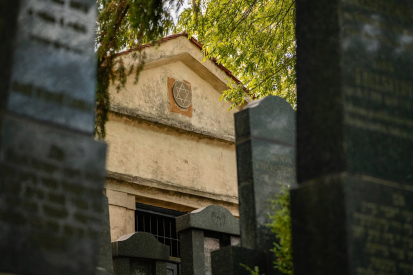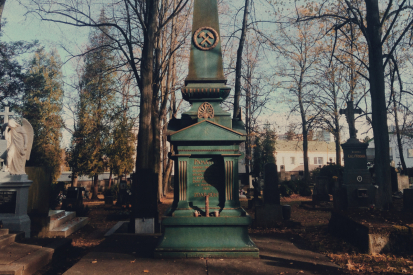Soulstice at Příbram cemeteries
Příbram preserves its stories from the past in three final resting places. The Příbram Cemetery, the Březohorský Cemetery and the Jewish Cemetery together form the chronicle of the city - from the reform of the Emperor, through the tragedies of mining disasters, to the legacy of many personalities whose life or work was linked to the city.
The Day of the Dead (November 2) is a day when (not only) Příbram is enveloped in a quiet atmosphere of remembrance. The cemeteries, guardians of the city's memory, come alive with thousands of candle lights and fresh flowers. Cemeteries are not only symbols of death, but above all monuments to a life that has passed but is imprinted in the collective memory of a place.
Příbram Cemetery
The Příbram Cemetery, located on the so-called Panská louka in Primář Václav Trnka Street, began writing its history in 1786. Its foundation was a direct consequence of the reforms of Emperor Joseph II, who forbade burials at churches inside towns. The first person to be properly buried here was Alžběta Machutová, née Škodová, on 26 January of the same year.
The grounds, dominated by the neo-Romanesque Chapel of the Holy Cross from 1870, are not only a place of rest but also a silent testimony to key events.
In the 1970s, for ideological reasons, burials were forbidden in the Municipal Cemetery. The change did not take place until after 1990. During the cemetery's existence, a number of notable funerary monuments have been created here, including a memorial to the 319 miners who perished in the huge mine fire at the Marie Mine in 1892. (The mass graves of the victims of the disaster are primarily located in Březohorské Cemetery; the mass grave here was later covered over.) Along the walls of the site are a number of tombs of notable residents. Honorary citizens, clergymen, artists and soldiers - legionnaires, participants of the First and Second World War and Soviet soldiers are buried here. A sad echo of the post-war history is the fact that with the departure of the German population many of the graves were abandoned.
Important personalities buried here:
- Drtikol František (1883-1961), photographer, painter, mystic.
- Juráček Pavel (1935-1989), film director and screenwriter.
- Kučera Fráňa (1897-1929), poet.
- Kašlík Václav (1917-1989), composer, conductor and dramaturge.
- Tesařík Richard, Gen. (1915-1967), hero of the battles on the Eastern Front during World War II.
- Beer Augustin (1815-1879), director of the Mining Academy in Příbram.
- Theurer Josef (1862-1928), the first rector of the Mining College in Příbram.
- And many others.
Other important memorials and graves:
- Grave of Soviet soldiers and partisans who died during the liberation in 1945.
- Memorial to the victims of the 1892 mining disaster in Březohorie
- Memorial to the soldiers of World War I
- Memorial to the victims of the communist dictatorship who perished in the Vojna and Bytíz prison camps after February 1948
- Memorial plaque to the displaced people of the Italian Valle di Ledro during World War I
- Liberation Memorial dedicated to the victims of the anti-Nazi resistance and the Holocaust from the Příbram region
Březohorské cemetery
The history of Březohorské Hory Cemetery is closely linked to the mining community, as Březové Hory was an independent town until 1953. The Březohorský Cemetery, often referred to as the "miners' cemetery", was founded together with the reconstruction of the St. Prokop Church in 1879 at the time of the main boom of the local mining industry. The cross in the centre of the cemetery bears the date of its opening.
The mining disaster of 1892 left the strongest traces here. At that time, it was the highest number of victims of a mining accident in history. Both the mass grave (where the miners were buried for hygienic reasons) and the Memorial to the Victims of the Marie Mine Fire have been preserved here. The memorial consists of an iconic double-chambered tomb with a cast-iron obelisk. In addition to the miners and their loved ones, 21 Italian refugees from the Valle di Ledro who died in Pribram during 1915-1919 found their final resting place here. At the end of World War II, Soviet soldiers were also buried here.
Important personalities buried here:
- Karel Hojden (†1975) - graphic designer, painter, illustrator and teacher.
- Hynek Klička ( †1879) - MP, mayor and honorary citizen of Březové Hory.
Jewish cemetery
Near the Municipal Cemetery there is a Jewish cemetery, founded in the same year as the Březohorský Cemetery, i.e. in 1879. This area of over 3,200 m² commemorates the once active Jewish community of the mining town.
The cemetery contains around 150 historical tombstones and a preserved ceremonial hall. After World War II, the cemetery gradually fell into disuse. The last burial took place here in 1958. The Memorial to the Jews of Příbram leaves a deep impression, commemorating the terrible toll of the war: 543 Jewish victims of the Holocaust from the Příbram region. Although it was damaged by vandals, thanks to reconstruction in the 1990s it is now protected as a cultural monument.
The Jewish cemetery is managed by the Matana company. Entrance is possible upon prior request for keys at the Příbram Information Centre, while the Municipal Cemetery and the Březohorský Cemetery are freely accessible to the public.
The three cemeteries of Příbram together preserve the history of the town in its purest form: quiet and dignified. When you go to light a candle this year, take a moment to look around. You may find that the stories of these places are not only about the past - but also about us, who are still remembering it.
If you are interested in learning more about the history of the cemeteries in Pribram, read the following article: https://www.poznejpribram.cz/pribramske-hrbitovy














